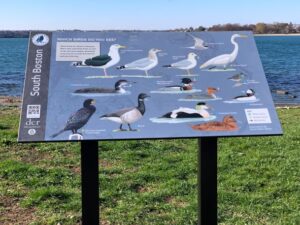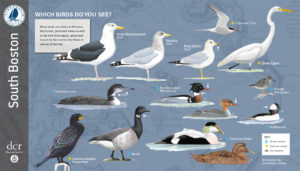Which Birds Do You See?
in South Boston
Many birds are drawn to Pleasure Bay’s calm, protected water as well as the rich food supply, generated in part by the current that flows in and out of the bay.
Illustrations by David Allen Sibley
Sign Location

More …
Resources
Sibley, David Allen. The Sibley Guide to Birds. Alfred A. Knopf, Second Edition, 2014.
Acknowledgments
This sign is made possible thanks to the city of Boston’s Community Preservation Act Fund.
Friends of the Boston Harborwalk thank the Massachusetts Department of Conservation & Recreation for their partnership.
Warm thanks to David Sibley for his renowned illustrations. We are very grateful to him and Wayne Peterson of the Massachusetts Audubon Society for their expertise and guidance.

